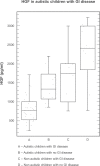Decreased Serum Hepatocyte Growth Factor (HGF) in Autistic Children with Severe Gastrointestinal Disease
- PMID: 20029653
- PMCID: PMC2796865
- DOI: 10.4137/bmi.s3656
Decreased Serum Hepatocyte Growth Factor (HGF) in Autistic Children with Severe Gastrointestinal Disease
Abstract
Aim: To assess serum Hepatocyte Growth Factor (HGF) levels in autistic children with severe gastrointestinal (GI) disease and to test the hypothesis that there is a relationship between GI pathology and HGF concentration.
Subjects and methods: Serum from 29 autistic children with chronic digestive disease (symptoms for a minimum of 6-12 months), most with ileo-colonic lymphoid nodular hyperplasia (LNH-markedly enlarged lymphoid nodules) and inflammation of the colorectum, small bowel and/or stomach), and 31 controls (11 age matched autistic children with no GI disease, 11 age matched non autistic children without GI disease and 9 age matched non autistic children with GI disease) were tested for HGF using ELISAs. HGF concentration of autistic children with GI disease was compared to GI disease severity.
Results: Autistic children with GI disease had significantly lower serum levels of HGF compared to controls (autistic without GI disease; p = 0.0005, non autistic with no GI disease; p = 0.0001, and non autistic with GI disease; p = 0.001). Collectively, all autistic children had significantly lower HGF levels when compared to non autistic children (p < 0.0001). We did not find any relationship between severity of GI disease and HGF concentration in autistic children with GI disease.
Discussion: These results suggest an association between HGF serum levels and the presence of GI disease in autistic children and explain a potential functional connection between the Met gene and autism. The concentration of serum HGF may be a useful biomarker for autistic children, especially those with severe GI disease.
Keywords: GI disease; autism; hepatocyte growth factor; met gene.
Figures




Similar articles
-
Low serum myeloperoxidase in autistic children with gastrointestinal disease.Clin Exp Gastroenterol. 2009;2:85-94. doi: 10.2147/ceg.s6051. Epub 2009 Aug 11. Clin Exp Gastroenterol. 2009. PMID: 21694831 Free PMC article.
-
Anti-metallothionein IgG and levels of metallothionein in autistic children with GI disease.Drug Healthc Patient Saf. 2009;1:1-8. doi: 10.2147/dhps.s4342. Epub 2009 Jan 8. Drug Healthc Patient Saf. 2009. PMID: 21701604 Free PMC article.
-
Low Serum Alpha-Antitrypsin Associated with Anti-PR-3 ANCA in Autistic Children with GI Disease.Genomics Insights. 2009 Jun 4;2:1-9. doi: 10.4137/gei.s2918. eCollection 2009. Genomics Insights. 2009. PMID: 26244018 Free PMC article.
-
Hepatocyte growth factor (HGF) as a potential index of severity of hypertension.Hypertens Res. 1999 Sep;22(3):161-7. doi: 10.1291/hypres.22.161. Hypertens Res. 1999. PMID: 10515437 Review.
-
Review article: intestinal lymphoid nodular hyperplasia in children--the relationship to food hypersensitivity.Aliment Pharmacol Ther. 2012 May;35(9):1000-9. doi: 10.1111/j.1365-2036.2012.05062.x. Epub 2012 Mar 20. Aliment Pharmacol Ther. 2012. PMID: 22428565 Review.
Cited by
-
Investigation of Gene Regulatory Networks Associated with Autism Spectrum Disorder Based on MiRNA Expression in China.PLoS One. 2015 Jun 10;10(6):e0129052. doi: 10.1371/journal.pone.0129052. eCollection 2015. PLoS One. 2015. PMID: 26061495 Free PMC article.
-
Discovery of a novel cytokine signature for the diagnosis of autism spectrum disorder in young Arab children in Qatar.Front Psychiatry. 2024 Feb 13;15:1333534. doi: 10.3389/fpsyt.2024.1333534. eCollection 2024. Front Psychiatry. 2024. PMID: 38414501 Free PMC article.
-
The enteric nervous system deficits in autism spectrum disorder.Front Neurosci. 2023 Aug 24;17:1101071. doi: 10.3389/fnins.2023.1101071. eCollection 2023. Front Neurosci. 2023. PMID: 37694110 Free PMC article. Review.
-
Decreased Serum Hepatocyte Growth Factor (HGF) in Individuals with Anxiety Increases After Zinc Therapy.Nutr Metab Insights. 2010 Aug 9;3:43-8. doi: 10.4137/NMI.S5495. eCollection 2010. Nutr Metab Insights. 2010. PMID: 23966791 Free PMC article.
-
Control of cortical synapse development and plasticity by MET receptor tyrosine kinase, a genetic risk factor for autism.J Neurosci Res. 2020 Nov;98(11):2115-2129. doi: 10.1002/jnr.24542. Epub 2019 Nov 19. J Neurosci Res. 2020. PMID: 31746037 Free PMC article. Review.
References
-
- Muhle R, Trentacoste SV, Rapin I. The Genetics of Autism. Pediatrics. 2004;113:e472–86. - PubMed
-
- Yeargin-Allsopp M, Rice C, Karapurkar T, Doernberg N, Boyle C, Murphy C. Prevalence of Autism in a US Metropolitan Area. J Am Med Assoc. 2003;289:49–55. - PubMed
-
- Le Couteur A, Bailey A, Goode S, et al. A broader phenotype of autism: the clinical spectrum in twins. J Child Psychol Psychiatry. 1996;37:785–801. - PubMed
-
- Fombonne E. Epidemiological surveys of autism and other pervasive developmental disorders: an update. J Autism Dev Disord. 2003;33:365–82. - PubMed
-
- Barrett S, Beck JC, Bernier R, et al. An autosomal genomic screen for autism. Collaborative linkage study of autism. Am J Med Genet. 1999;88:609–15. - PubMed
LinkOut - more resources
Full Text Sources
Other Literature Sources
Miscellaneous

